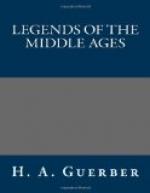[Sidenote: Aslaug.] This answer, which perhaps gave rise to the common expression, “A little bird told me,” greatly astonished Ragnar. He was about to try to excuse himself when Krake, drawing herself up proudly, declared that while she was perfectly ready to depart, it was but just that he should now learn that her extraction was far less humble than he thought. She then proceeded to tell him that her real name was Aslaug, and that she was the daughter of Sigurd Fafnisbane (the slayer of Fafnir) and the beautiful Valkyr Brunhild. Her grandfather, or her foster father, Heimir, to protect her from the foes who would fain have taken her life, had hidden her in his hollow harp when she was but a babe. He had tenderly cared for her until he was treacherously murdered by peasants, who had found her in the hollow harp instead of the treasure they sought there.
“Let be—as
ancient stories tell—
Full knowledge upon Ragnar
fell
In lapse of time, that this
was she
Begot in the felicity
Swift-fleeting of the wondrous
twain,
Who afterwards through change
and pain
Must live apart to meet in
death.”
WILLIAM
MORRIS, The Fostering of Aslaug.
In proof of her assertion, Aslaug then produced a ring and a letter which had belonged to her illustrious mother, and foretold that her next child, a son, would bear the image of a dragon in his right eye, as a sign that he was a grandson of the Dragon Slayer, whose memory was honored by all.
Convinced of the truth of these statements, Ragnar no longer showed any desire to repudiate his wife; but, on the contrary, he besought her to remain with him, and bade his subjects call her Aslaug.
[Sidenote: Sigurd the Snake-eyed.] Shortly after this reconciliation the queen gave birth to a fifth son, who, as she had predicted, came into the world with a peculiar birthmark, to which he owed his name—Sigurd the Snake-eyed. As it was customary for kings to intrust their sons to some noted warrior to foster, this child was given to the celebrated Norman pirate, Hastings, who, as soon as his charge had attained a suitable age, taught him the art of viking warfare, and took him, with his four elder brothers, to raid the coasts of all the southern countries.
Ivar, the eldest of Ragnar and Aslaug’s sons, although crippled from birth, and unable to walk a step, was always ready to join in the fray, into the midst of which he was borne on a shield. From this point of vantage he shot arrow after arrow, with fatal accuracy of aim. As he had employed much of his leisure time in learning runes[1] and all kinds of magic arts, he was often of great assistance to his brothers, who generally chose him leader of their expeditions. [Footnote 1: See Guerber’s Myths of Northern Lands, p. 39.]
While Ragnar’s five sons were engaged in fighting the English at Whitaby to punish them for plundering and setting fire to some Danish ships, Rogenwald fell to rise no more.




